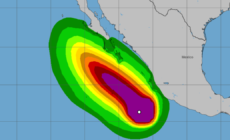-
Supreme Court Kicks Off New Term: What to Know - 17 mins ago
-
Priscilla strengthens into a hurricane in the Pacific. Maps show its path. - 19 mins ago
-
Daulton Varsho's two-run home run widens Blue Jays' lead over Yankees - 41 mins ago
-
Saints Make Historical Alvin Kamara Announcement After Beating Giants - 56 mins ago
-
Keith Urban’s guitarist draws attention amid divorce and fan speculation - about 1 hour ago
-
“If you’re Schottenheimer, you’re feeling pretty good” — Cowboys roll to dominant win over Jets 😎 - about 1 hour ago
-
Cigarette-Smuggling Balloons Force Lithuanian Airport Closure - 2 hours ago
-
Hailey Bieber, Heidi Klum and Charlize Theron stun at fashion shows - 2 hours ago
-
Colts are a 'For Real Contender' after CRUSHING Raiders in Week 5 | NFL on FOX - 2 hours ago
-
DraftKings Promo Code: Claim $200 Bonus For NFL Late Games, Bills-Patriots - 2 hours ago
Map shows which states’ economies are growing—and shrinking—this year
New data has shown that the U.S. economy has picked up at a significant pace in the second quarter of 2025.
On Thursday, the Bureau of Economic Analysis (BEA) released its third and final estimate for gross domestic product (GDP) growth from April to June, reporting that the economy has grown by 3.8 percent at a seasonally-adjusted annual rate. This represents an upward revision from the earlier estimate of 3.3 percent, and a significant rebound from the 0.6 percent contraction recorded in the first quarter.
On Friday, the BEA reported that real GDP increased for 48 states in the second quarter, with growth reaching as high as 7.3 percent in North Dakota.
Why It Matters
America’s economic outlook has recently been clouded by weak jobs data and surveys revealing declines in consumer confidence, together driving some fears of a possible recession.
The latest GDP figures, however, alongside Thursday’s reports of falling jobless claims and a narrowing trade deficit—both of which have exceeded expectations—have eased some of these concerns for some and have been taken by the White House administration as validation of President Donald Trump’s economic agenda.
What To Know
The map below, created using the BEA’s latest data release, shows how each states’ inflation-adjusted GDP has changed from the first to the second quarters of 2025.
According to the BEA, growth rates in the second quarter ranged from a modest 0.4 percent in Hawaii to 7.3 percent in North Dakota. This marks a significant change from the first quarter, in which no state saw growth greater than 4.2 percent (Massachusetts) and the majority recorded year-over-year declines.
Washington, D.C., recorded no annual change in GDP in the second quarter, and only two states saw their GDP drop compared to the previous year—Arkansas by 1.1 percent and Mississippi by 0.9 percent.
In addition to GDP boosts, the Census Bureau also reported on Thursday that America’s trade deficit had narrowed to $85.5 billion in August, well below the projected $95.7 billion. Meanwhile, the Department of Labor announced that initial jobless claims had fallen by 14,000 to 218,000 for the third week of September, reaching their lowest level in two months.
What People Are Saying
The White House, reacting to the GDP figures, wrote: “Second-quarter GDP was revised up to 3.8 percent—once again proving the so-called ‘experts’ wrong as strong consumer spending, rising incomes, and a narrowing trade gap define President Donald J. Trump’s economic resurgence.”
Bill Adams, Chief Economist for Comerica Bank, told Newsweek: “The trade deficit shrank sharply in August as tariff frontrunning stopped. August’s trade balance is a tailwind to third quarter GDP, since it implies more U.S. spending went to domestically-produced goods and services rather than imports.”
“The latest GDP and jobless claims data should ease the bout of anxiety kicked off by the weak August jobs report and downward revisions to benchmark employment data published September 9,” he added.
What Happens Next?
The Commerce Department will release its advance estimate for third-quarter GDP on October 30, followed by a final reading and state-level estimates in December.
Source link































